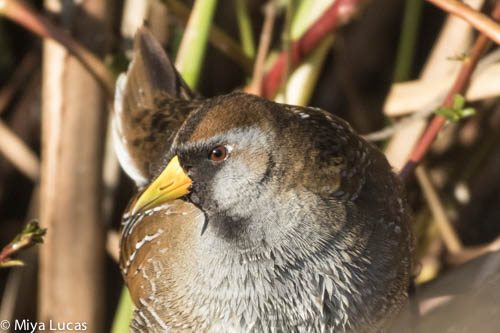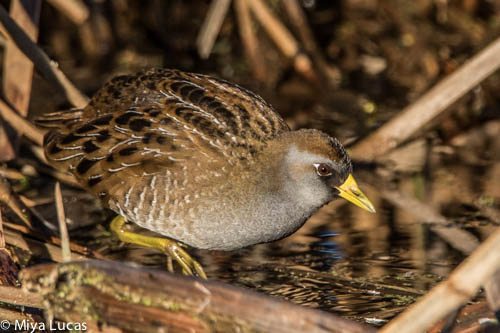The secretive Sora
By Miya Lucas
Sora is the name of a fictional character in a Japanese video game. Sometimes trying to view a Sora rail is so challenging that you may feel like it is a fictional character as well.
Soras are secretive and stealthy. I enjoy hearing the Sora’s call and song, and occasionally seeing the actual bird, at Las Gallinas Sanitary Ponds in San Rafael, where I lead a monthly field trip with Wendy Beers. We in the Bay Area are fortunate to live in one of just two regions – northern/central California, and southern Arizona/New Mexico – that are home to Soras year-round. Their preferred habitat is freshwater marshlands, usually with a water depth of 12 to 20 inches.
“Thin as a rail”: The phrase originally referred to a fence or a bar. However, it would be an appropriate phrase for a Sora rail as well. Although the Sora’s length is 8 to 10 inches, it can compress its chest wall to a width of 1.5 inches, allowing it to walk in and out of thick-growing reeds or cattails. If threatened, it sometimes dives for cover under water and all you can see is its yellow beak sticking out.


The male Sora is just a tad larger than the female. They look very similar and both have a bright yellow beak, but the female Sora has lighter black coloring on her face and throat.
I especially enjoy hearing the Sora’s call. It reminds me of the childhood game of tag, like a child’s high, sing-song voice shouting….yourit! yourit! yourit! They also have a loud, fast horse-like whinny that slows down so you can hear each note. The best opportunity to hear a Sora is during mating season.
They can also be heard at night, in spring migration, and when feeding.
Sora courtship behavior has three stages. The first stage is visual — what I call the flirty stage. The male and female stand near one another for 15 to 30 minutes, watching and being watched. The second stage continues the watching but adds grooming or preening before the other Sora. If all goes well, in about two to four weeks, the Soras move on to preening and grooming each other. Soon afterwards, copulation occurs.
Nest construction is done by both the male and female. The male Sora brings materials, and the female constructs the nest. Soras make several nests — one for laying their eggs, and additional ones for use as resting platforms or feeding sites for young birds.
They lay 8 to 11 eggs, and the young hatch over a period of about a week. After hatching, they don’t leave the nest for about four days. The nest is constructed with a “ramp” that allows the young birds to run up and down into the water.
The Sora is one of seven types of rails in North America. Its bill is uniquely short and conical, rather than long and slender. (The British also refer to the Sora as a crake, which is the British generic name for short-billed rails.)

The most abundant rail in North America, the Sora is subject to hunting in 31 states. (California does not consider Sora game birds, so they cannot be legally hunted here.) Although the North American Breeding Bird Survey 1966-2014 concludes that its numbers are stable, the North American Waterbird Conservation Plan lists it as a Species of High Concern. Given that the Sora’s freshwater marsh habitat is dwindling with urbanization, it is likely that its numbers could decrease in future years.
As secretive as Soras are, it’s well worth the effort to try to see them. If you scan the edge of a marsh at water level, they may magically appear and disappear among the reeds. Look for them at the water’s edge and if you’re patient and persistent, you will be rewarded.
Miya Lucas, an avid birder and photography fanatic, just completed the year-long Master Birding Class co-sponsored by Golden Gate Bird Alliance and California Academy of Sciences. One of her favorite places to bird in the Bay Area is Las Gallinas Storage Ponds. Check our Field Trips web page to find the date of her next monthly field trip to Las Gallinas.
